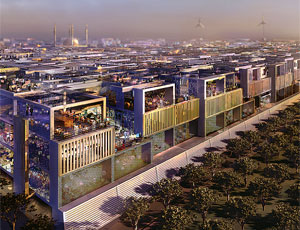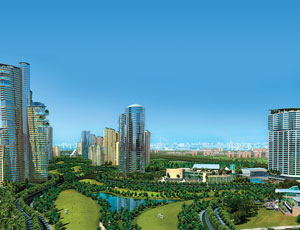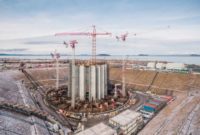As the U.S. credit crisis dampens the market for domestic general building projects, contractors and designers with the ability to work globally are eyeing foreign prospects more than ever.
While North American and European markets are freezing up, causing projects to be delayed, scaled back or canceled, design and construction markets in Asia and the Middle East are still being propelled by the momentum of a spate of major development and infrastructure projects. In Asia and especially the Middle East, massive-scale projects to build and design self-contained cities and huge residential, office and entertainment complexes are drawing designers, project managers and other construction skills from the West in large numbers.


Markets in Asia and the Middle East are rapidly becoming a haven for western contractors and designers as they face dramatically dwindling opportunities at home, says Callum MacBean, managing director of the Shanghai office of San Francisco-based Gensler. The architectural firm is busy with many projects throughout China, Vietnam, Singapore, South Korea and India, and this year picked up a commission to design Shanghai Tower, expected to be China’s tallest skyscraper at 632 meters. “The recession in the West has not significantly affected markets in China yet,” says MacBean. “For architects in the West wanting to work in China, the boom is still going on. China is typically three to four years behind the U.S.”
Multi-billion-dollar projects in United Arab Emirates, Saudi Arabia, Dubai and China represent a developement trend that has pushed project sizes and scopes to new levels. “The Middle East is booming with trophy projects,” says Tom Searle, president of Englewood-Colo.-based CH2M Hill International. “Middle Eastern and Asian countries know that the only way to be competitive globally is to invest in development and infrastructure. They all want to be First World countries.”
Most of the work in the Middle East is centered in UAE and Saudi Arabia, where there are 250 major construction projects in the pipeline with a combined value of $120 billion. The projects, 135 in UAE and 60 in Saudi Arabia, range in value from $12 million to $13.6 billion. In the entire Persian Gulf region, more than 3,800 construction projects are either planned or under way, representing about $3.4 trillion in value, according to a report from the Big 5 Construction Conference and Exhibition, held in Dubai in November.
Cities Rising
Among the megaprojects are three in Dubai, including the $64-billion entertainment complex and city Dubailand, $54-billion Mohammad Bin Rashid Garden City and $350-billion Jumeirah Gardens. Largely centered in the Middle East, the trend to build self-contained planned cities containing the residential, infrastructure and commercial components to support tens of thousands of new residents is an example of developing nations’ Herculean push for economic growth. Flush with prosperity, developers and governments in the Middle East are in a big hurry to make their oil-rich nations a destination for western tourists and investors, with projects like Kuwait’s $132-billion Silk City and UAE’s Jumeirah Gardens Development, which are planned to be fully self-contained communities with the capacity to house 70,000 and 60,000 residents, respectively. One of the largest megaprojects is the King Abdullah Economic City project in Saudi Arabia, which when completed in 20 years, will be the size of Washington, D.C., with a population of more than 1.4 million people.
The projects are big in scale and complex in scope. Dubailand alone includes 45 major projects and 200 subprojects, of which 22 currently are under way. Russia’s version of the megaproject is the Crystal Island project in Moscow, a $4-billion planned city to be enclosed with a massive structure covering a total floor area of 2.5 million sq meters. It will house 30,000 residents when completed in 10 years. The project is being designed by London-based architect Foster + Partners.
The megaprojects proliferating in Asia and Middle East invariably involve a cornucopia of foreign investors, designers, contractors and subcontractors. “International companies are looking to the Middle East as one of the few regions that is still maintaining a good level of growth,” says Helal Al Merri, director general of Dubai World Trade Center.
CH2M Hill is managing development of a $22-billion Masdar City megaproject in UAE, a 2.3-sq-mile planned city that will rely solely on solar and renewable-energy sources. When fully completed by 2014, the city will house 50,000 people and have a zero carbon footprint, says Searle.
CH2M Hill also is construction manager for London’s 2012 Summer Olympics, a $4-billion program that will include an 80,000-seat stadium, housing and related infrastructure.
Like CH2M Hill, Seattle-based designer Callison does a significant portion of its work overseas. “We have been involved in the Asian market for 18 years and 40% of our revenue is from abroad,” says Bill Gartz, a principal at Callison who oversees the firm’s international and commercial projects. Among its many projects throughout Asia, the firm is doing design work on Dubai’s Eye Park, a five-tower complex within Dubailand designed to the U.S. Green Building Council’s Leadership in Energy and Environmental Design standards. It will contain about 1.9 million sq ft of residential space and 100,000 sq ft of retail. The firm also is designing a 16.1-million sq-ft residential development in Noida, India.
Western contractors and designers say Asian developers are evolving as they begin to embrace Western approaches to sustainability and design and building. “Green design is a huge issue in the Middle East right now, and the region is positioning itself to be a leader in green design and sustainability,” says Gartz. The Chinese construction industry “is maturing. Developers are now taking a more fiscally responsible approach to projects...and developing a more western, analytical approach to building,” says Gartz.
“The energy in China is really exciting right now,” says MacBean. “There is a real can-do attitude. Things are evolving for the better, construction materials and work quality is getting better and more projects are being realized.”
But “there is still a problem of a lack transparency on many projects in China, and projects are often delayed by bureaucracy,” notes Searle. “There is still a tendency to go for low-cost solutions rather than value solutions, and the safety culture is not viewed as seriously as it is in the West.”
Perennial challenges for global firms are “the cultural and language barriers that we have to deal with on projects in other nations,” says MacBean. He says the 126 employees in Gensler’s Shanghai office are required to have language training. “You have to learn how to do things here. It takes time to learn how the culture works,” says MacBean.
When New York-based architect Cook+Fox did a pro bono project to design a visitors center in Siem Reap, Cambodia, last year, the project team found it “extremely difficult to supervise construction due to the language barrier,” says partner Serge Appel. “When you do a small project in Asia, rather than a five-star hotel project, you are much more reliant on the local contractors and subcontractors to do the job, and communication can be a real problem.”
Sources say the Asian and Middle Eastern markets will be a beacon for foreign designers and contractors in the upcoming months as Western economies flounder. “We may see a flattening out of the markets in a year of two, but for now, the Chinese developers are bullish,” says MacBean.


Post a comment to this article
Report Abusive Comment